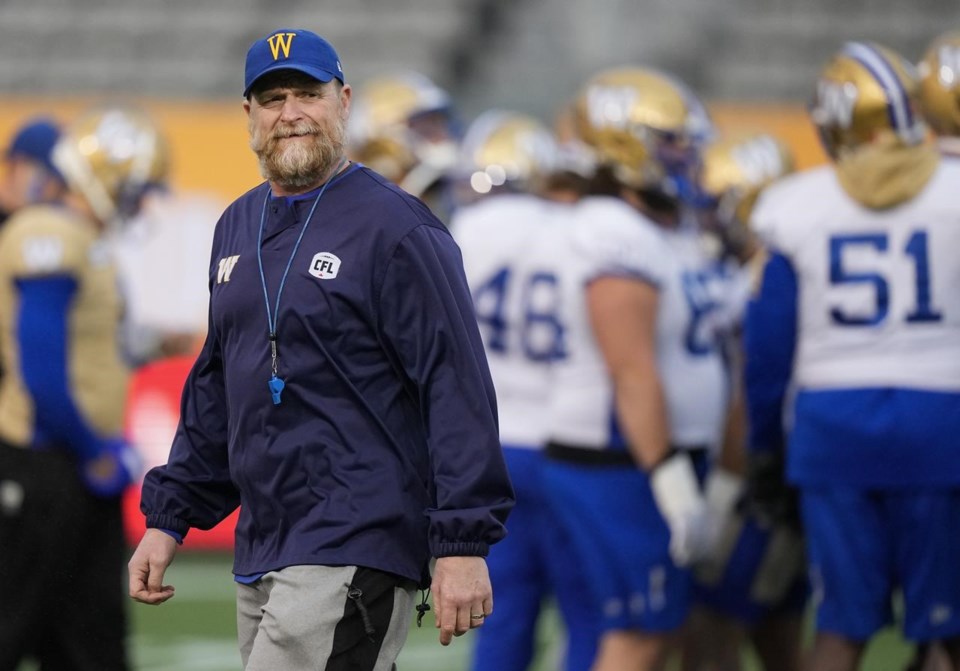WINNIPEG — Mike O’Shea and his CFL colleagues don't need convincing about the value of Canadian players.
Their actions back up their words.
Seventy per cent of players selected in CFL drafts since 2000 have played at least one game in the league, according to head statistician Steve Daniel.
The rosters in the final week of the '23 regular season (active and injured list) featured 552 players, including 289 Americans, 247 nationals and 16 global competitors.
‚ÄúOne of the things (the numbers) tell me is whoever‚Äôs saying Canadian talent is lacking is mistaken,‚Äù said O‚ÄôShea, who‚Äôs coached the Winnipeg Blue Bombers to four straight Grey Cup appearances and two victories.¬Ý
“I think players are getting better. They’re well-coached, they’re serious about trying to make our league and it's a dream that guys are realizing.”
O‚ÄôShea and his league counterparts are here for the CFL's national combine. Coaches and general managers will interview and watch 84 national and global prospects go through drills and practises from Thursday to Sunday, hoping to ultimately hear their names called at either the CFL global or Canadian drafts April 30.¬Ý
If selected, players may see game action sooner than later.
Of the 72 players drafted last year, 30 appeared in at least one game. There were 74 players selected in 2022, with 50 having hit the field.
“Probably the No. 1 way you build a sustainable football team is through drafting well in the Canadian draft,” said Rick Campbell, the B.C. Lions head coach/co-GM. “This past season, we played more snaps of Canadians than any other team.
"We don’t do that just to prove a point to play Canadians. We play them because we think they’re good football players.”
The Lions and Bombers are –°¿∂ ”∆µ rewarded this year for their Canadian players‚Äô skills. The CFL counted the number of snaps nationals took for each team last season and gave the top two clubs a bonus.¬Ý
B.C. had the most so it gets an extra selection at the end of the second round in this year’s draft (19th overall). Winnipeg was next and received the 20th pick.
Since becoming an assistant coach in 1999 with the then-Edmonton Eskimos, Campbell has seen the evolution of Canadian players.
‚ÄúTo see it from 20 years ago, 15 years ago, 10 years ago, five years ago how much more prepared these guys are, I just think U Sports keeps going up in the talent level, the coaching,‚Äù Campbell said, referring to the Canadian university ranks.¬Ý
‚ÄúYou can see when these guys come here to do all these drills and audition for everyone, basically, they‚Äôre just way more ready to go ‚Äî physically, mentally. They‚Äôre much closer to –°¿∂ ”∆µ able to play pro football.‚Äù
Danny Maciocia, GM of the reigning Grey Cup champion Montreal Alouettes, watched Canadian receiver Tyson Philpot — a '22 first-round pick — catch the winning touchdown in the club's 28-24 upset win over Winnipeg last November.
It wasn't just the Delta, B.C., native's play that made Montreal successful, Maciocia said. Other Canadians also played a major role.¬Ý
“We’re not afraid about playing them,” he said. “We feel fairly confident we can line up with them and win with them.
“I think it’s just a mindset. Just got to give them an opportunity to do so because they belong on that field like everyone else.”
Last season, 667 players got into at least one game. That included 219 players from U Sports schools, 440 out of the NCAA and eight from other educational institutions.
The universities that produced most of the U Sports alumni were Calgary (18), Laval and Montreal (16 each), Wilfrid Laurier (15), Western (13) and Saskatchewan (11).
Maciocia knows the Canadian university ranks well. He coached the University of Montreal Carabins to their first Vanier Cup championship in 2014.
“I’m a big proponent of U Sports and the type of player they’ve been able to graduate at the next level," he said. “The gap has really been reduced.
"Some of them can just come up (to the CFL) and play, play right away, or maybe they’re just a year removed. But the amount of players that are able to graduate to the next level and impact their respective teams is as great as I’ve ever seen it.”
CFL teams must have 21 nationals on their roster, with seven starters on offence or defence.¬Ý
“We’ve chosen the Canadian player over the American time and time again,” said Toronto Argonauts GM Mike (Pinball) Clemons. “We've have been playing with one, two and a couple of times three additional Canadian players just because they were the best player, they were the best option.”
¬ÝThis report by The Canadian Press was first published March 20, 2024.
Judy Owen, The Canadian Press




